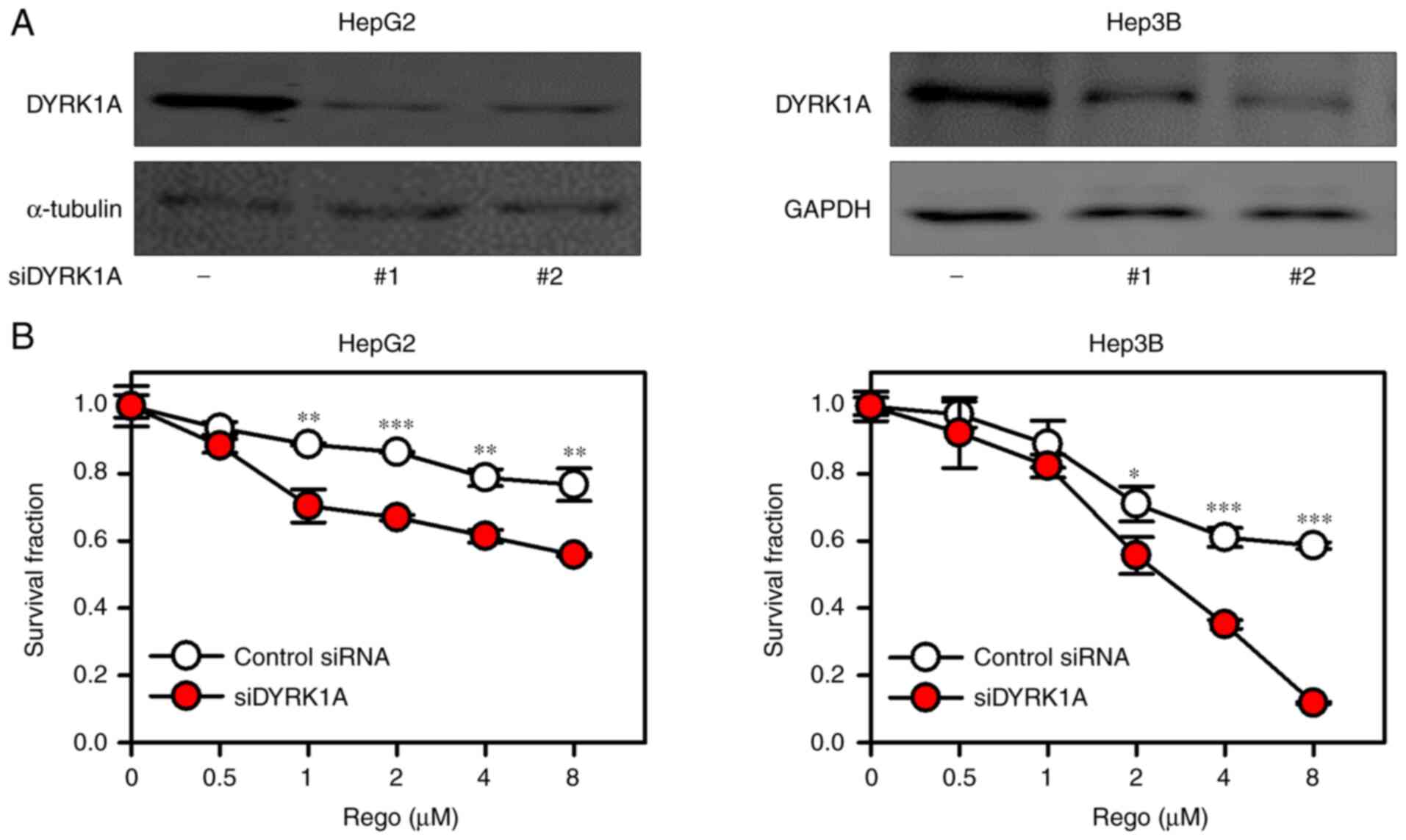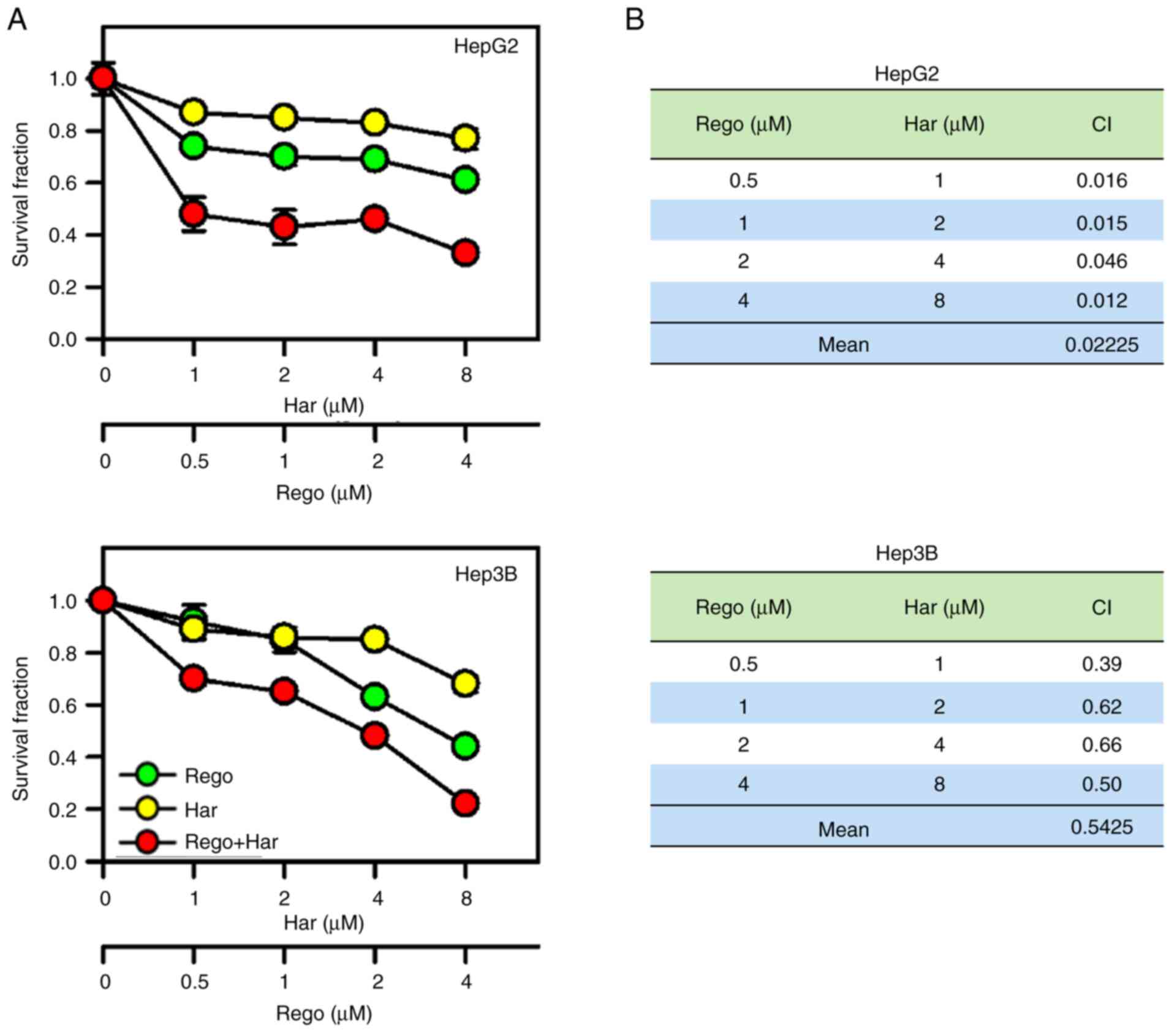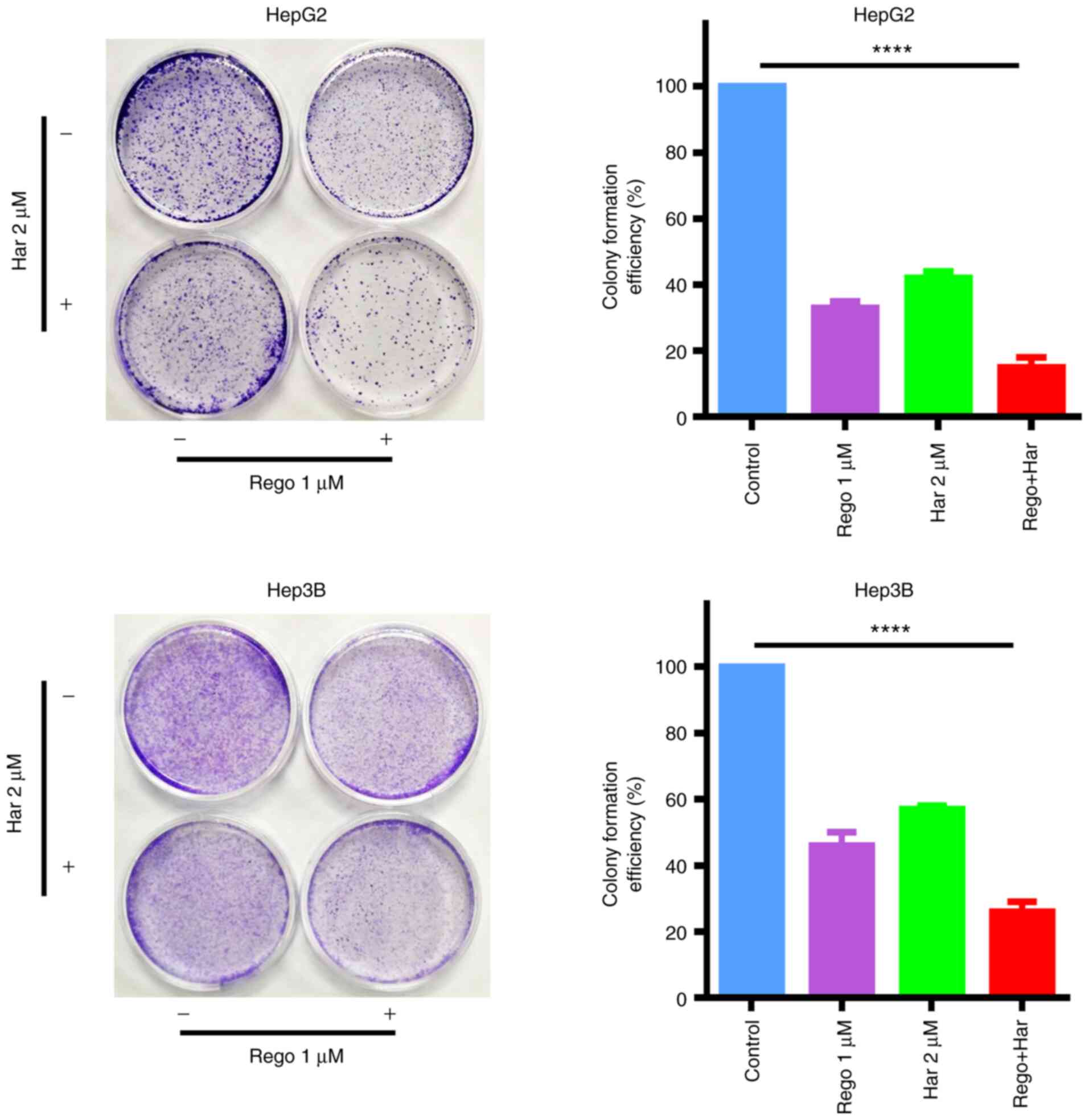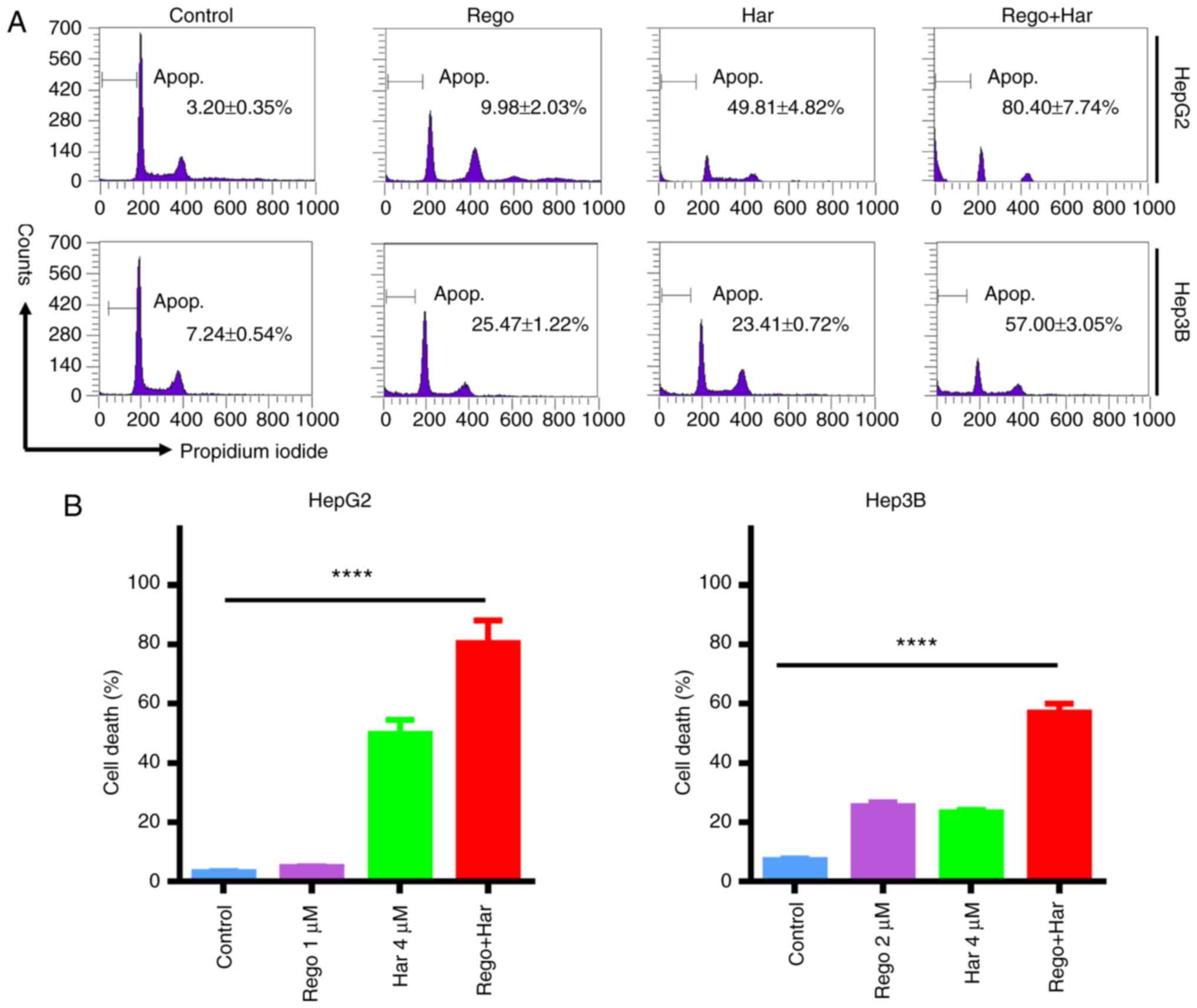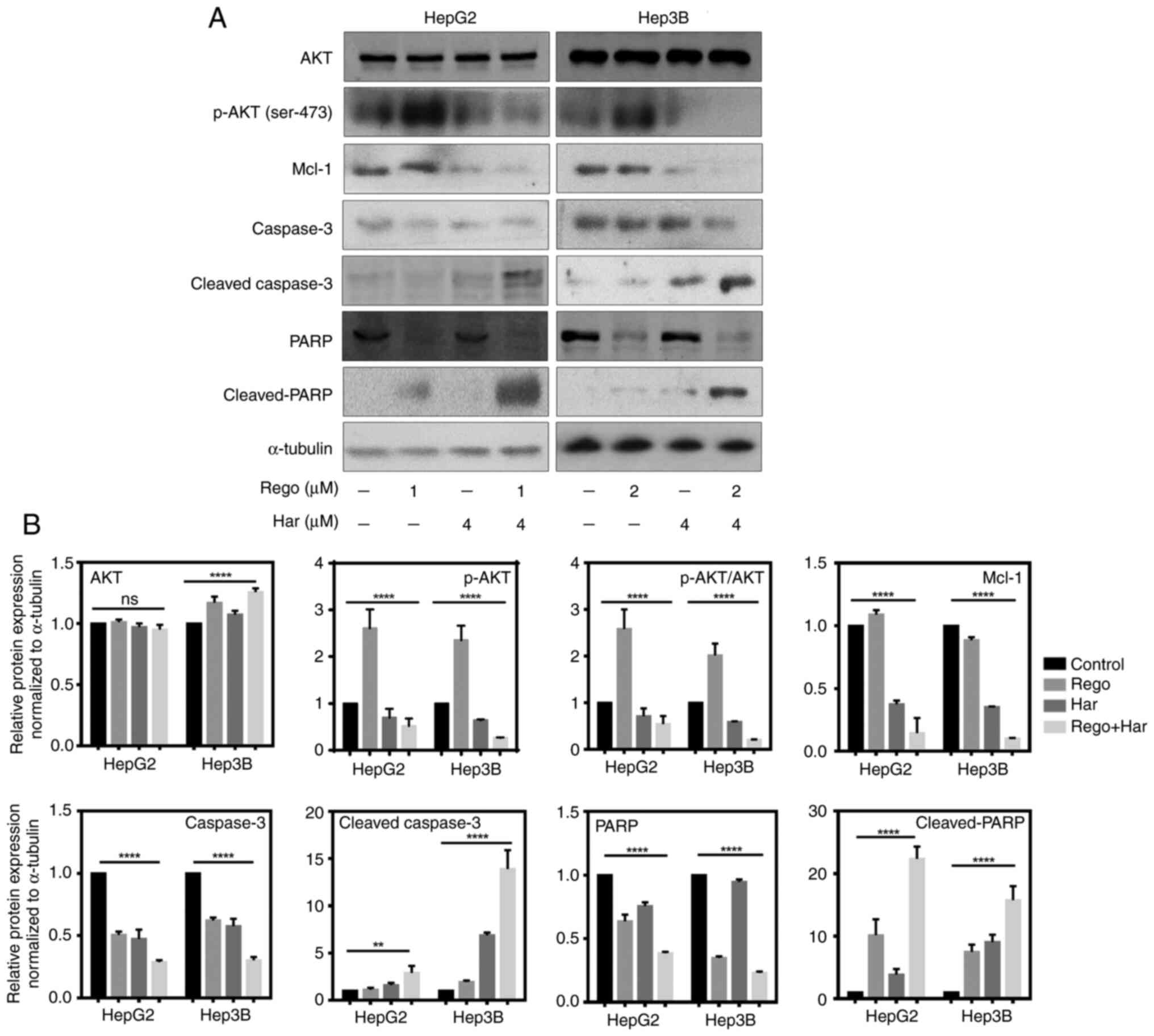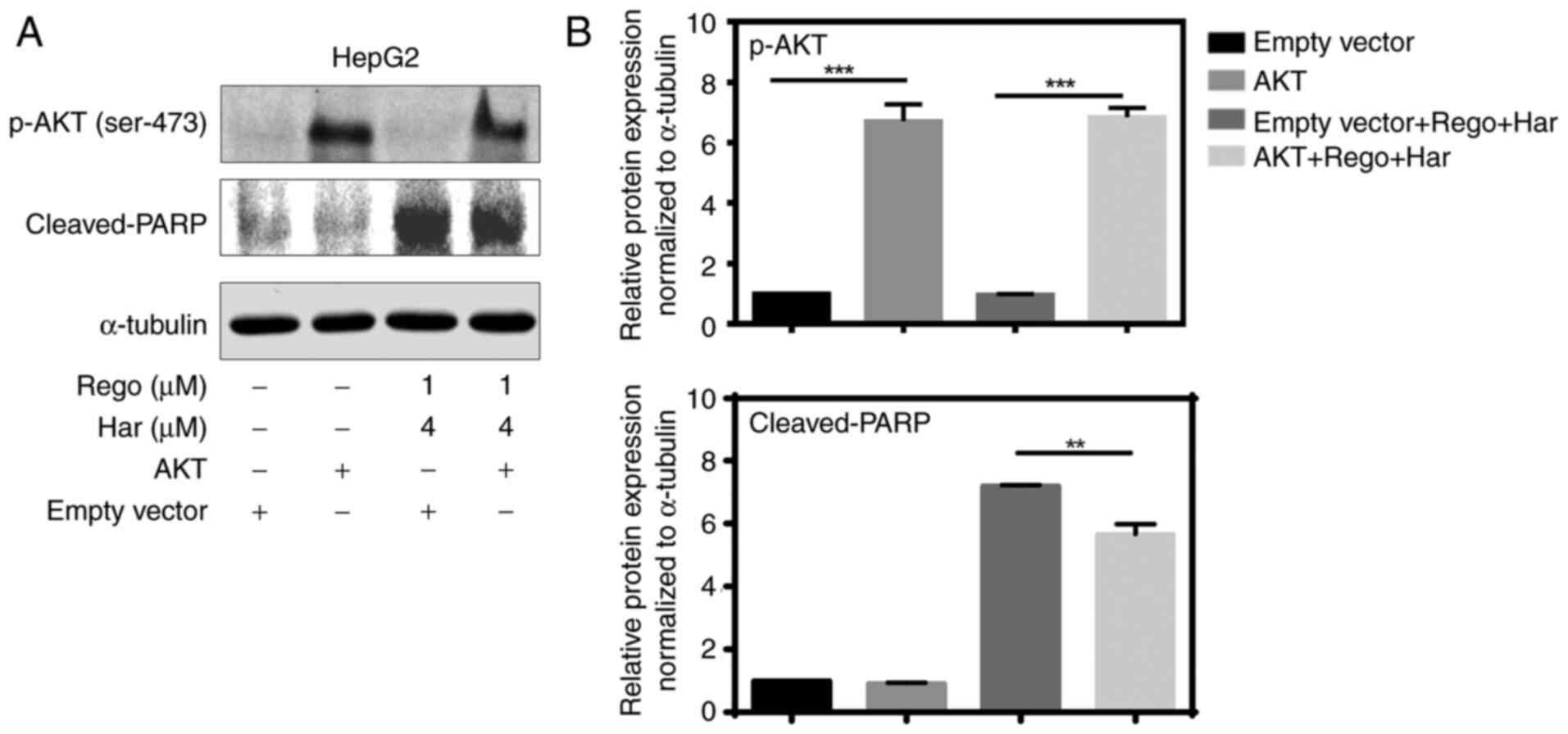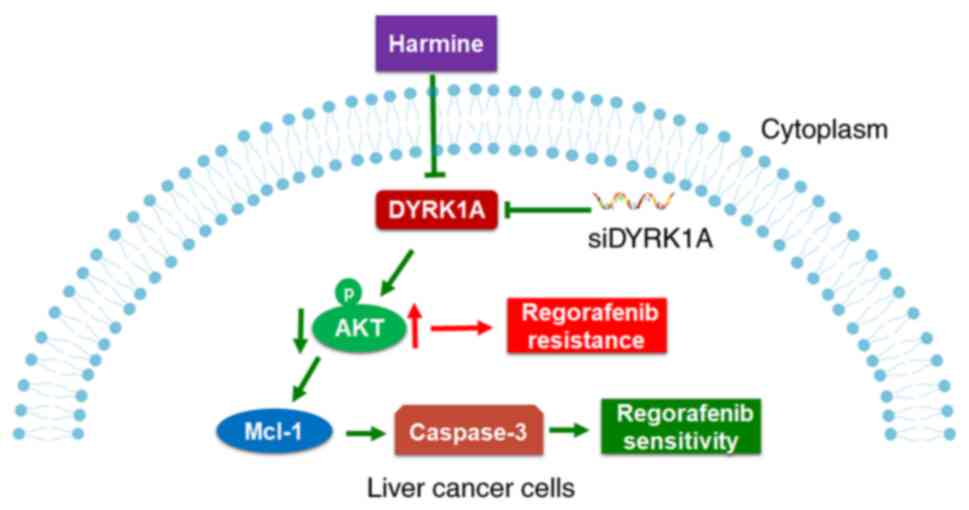Harmine reinforces the effects of regorafenib on suppressing cell proliferation and inducing apoptosis in liver cancer cells
- Authors:
- Published online on: January 7, 2022 https://doi.org/10.3892/etm.2022.11132
- Article Number: 209
-
Copyright: © Chen et al. This is an open access article distributed under the terms of Creative Commons Attribution License.
Abstract
Introduction
Liver cancer is the sixth common cancer and the second leading cause of death from cancer worldwide, which is frequently diagnosed at late stage and characterized by rapid progression (1,2). Patients with advanced liver cancer are ineligible for surgical resection and other potentially curative treatments (3). In addition, treatment efficacy for liver cancer is poor, due to its resistance to conventional chemotherapy (4,5). After decades of searching for effective therapeutic agents for liver cancer, systemic treatment with sorafenib has been established as the standard therapy for advanced liver cancer (6). Furthermore, regorafenib has been demonstrated to have a high efficacy and safety in patients who experience liver cancer progression during sorafenib treatment (7). Regorafenib, a bi-aryl urea compound, is an antiangiogenic and antitumorigenic agent approved for the treatment of patients with advanced liver cancer during sorafenib therapy; it inhibits tumor growth by targeting multiple kinases, including vascular endothelial growth factor receptors 1-3, platelet-derived growth factor receptor β, c-KIT, RET, B-RAF, fibroblast growth factor receptor 1 and serine/threonine kinase (Raf and p38 MAPK) (8). Regorafenib has been revealed to suppress cell proliferation, invasion and angiogenesis via the ERK/NF-κB signaling pathway (9). However, patients with advanced liver cancer develop resistance to regorafenib via the activation of the AKT signaling pathway, and the overall outcome of patients with advanced liver cancer is far from satisfactory (10). Therefore, the development of more effective therapeutic agents and strategies for liver cancer is required.
Harmine, a naturally occurring β-carboline, is isolated from a medicinal herb traditionally used in the Middle East and North Africa, known as Peganum harmala L. (11). It has a wide range of pharmacological activities, including anti-microbial, anti-fungal, anti-oxidative and anticancer activities (12). Furthermore, harmine is an ideal drug candidate for liver cancer therapy, as it is selectively harmful to liver cancer cells but has minimal side effects on normal liver cells (13). Harmine possesses notable anticancer properties by targeting apoptosis, autophagy, abnormal cell proliferation, angiogenesis and metastasis (14). Harmine displays pharmacological activities by suppressing substrate phosphorylation in the dual-specificity tyrosine-regulated kinase (DYRK) family, and it exhibits the highest affinity for DYRK1A (15). Furthermore, combining harmine with other agents, such as Bcl-2 inhibitors and osimertinib, has been identified as a potential approach to overcoming resistance to chemotherapy (16,17). In the present study, it was examined whether harmine combined with regorafenib may be a potential therapeutic regimen for liver cancer treatment.
Materials and methods
Materials
Harmine (cat. no. HY-N0737A) was purchased from MedChemExpress and regorafenib (cat. no. A8236) was obtained by APeXBIO Technology LLC. The primary antibodies against cleaved-caspase-3 (cat. no. 9661S), cleaved-poly (ADP-ribose) polymerase (cleaved-PARP; cat. no. 9541S; 1:1,000) and DYRK1A (cat. no. 2771S; 1:1,000) were obtained from Cell Signaling Technology, Inc. The primary antibodies against PARP-1/2 (H-250) (cat. no. sc-7150; 1:500), anti-GAPDH antibody (FL-335) (cat. no. sc-25778; 1:500), myeloid cell leukemia-1 (Mcl-1) (S-19) (cat. no. sc-819; 1:500), phosphorylated (p)-AKT (1/2/3) (Ser473) (cat. no. sc-7985; 1:500) and caspase-3 (H-277) (cat. no. sc-7148; 1:500) were purchased from Santa Cruz Biotechnology, Inc. The primary antibody against α-tubulin (rabbit polyclonal antibody; cat. no. AF0001; 1:1,000) was obtained from Beyotime Institute of Biotechnology. The primary antibody against AKT (cat. no. 610836; 1:500) was purchased from BD Biosciences. The secondary antibodies, including DyLight™ 800 4X PEG-conjugated anti-rabbit-IgG (cat. no. 5151) and DyLight™ 800 4X PEG-conjugated anti-mouse-IgG (cat. no. 5470), were obtained from Cell Signaling Technology, Inc.
Cell culture
All cell lines were obtained from the Shanghai Institute of Biochemistry and Cell Biology. HepG2 cells were maintained in DMEM (cat. no. C0006; Hangzhou Keyi Shengwu Jishu Youxian Gongsi) with 10% FBS (cat. no. P30-3302; PAN-Biotech GmbH) and Hep3B cells were cultured in MEM (cat. no. C0032, Hangzhou KEYI) with 10% FBS and 100 U/ml penicillin/streptomycin (Gibco; Thermo Fisher Scientific, Inc.). Mycoplasma testing was performed on these cell lines, which were then determined and authenticated for genotypes using short tandem repeat DNA fingerprinting and passaged for <6 months (18). Liver cancer cells were divided into four groups: control group treated with DMSO, harmine treated group, regorafenib treated group, harmine plus regorafenib group.
Cytotoxicity assay
The proliferation of HepG2 and Hep3B cells was measured using sulforhodamine blue (SRB) cytotoxicity assay. The cells were inoculated into a 96-well plate at a density of 8x103 cells/well. When the cell confluence reached 30%, harmine, regorafenib, harmine plus regorafenib were added into the plates. After 72 h, cells were fixed with 10% trichloroacetic acid for 8 h at 4°C. Next, tap water was used to wash the 96-well plates. After the wells had dried up, 0.4% SRB (cat. no. 230162-5G; Sigma-Aldrich; Merck KGaA) solution was used to stain the cells 30 min at room temperature. Next, the unbound dye was removed using 1% acetic acid washing in the 96-well plates. Tris-based solution (10 mM) was used to solubilize the SRB dye. Finally, cell proliferation was detected as previously described using a microplate reader at 570 nm (19).
Detection of cell death
Cell death was detected using PI (cat. no. ST511; Beyotime Institute of Biotechnology) followed by flow cytometry detection as previously described (20). HepG2 and Hep3B cells were inoculated at a density of 2x104 per well into a 96-well plate and incubated with harmine (4 µM) and/or regorafenib (1 µM or 2 µM) for 48 h at 37°C. The collected cells were then fixed and permeabilized with 75% precooled ethanol at 4˚C for 2 h. Next, 400 µl PBS containing 50 µg/ml RNase A (cat. no. ST579; Beyotime Institute of Biotechnology) was used to treat cells at 37˚C for 30 min. Subsequently, cells were incubated with 5 µl PI solution for 15 min at room temperature and analyzed using a FACSCalibur cytometer (FACSCalibur; BD Biosciences). Finally, the sub-G1 peak was analyzed by Cellquest Pro Software (version 6.0; BD Biosciences), and gating was performed to keep cell death <10% in the control group.
Colony formation assay
HepG2 and Hep3B cells were inoculated into a 6-cm dish at a low cell density (6x103 cells per dish) to evaluate the ability of cells to form colonies. Then, the cells were incubated with 1 µM harmine, 2 µM regorafenib and harmine plus regorafenib for 14 days at 37°C. The sensitivity of drug treatment is dependent on cell density, drug treatment was indicated to achieve maximal anti-proliferative effect at low cell density and retain the anti-proliferative effect at intermediate cell density (data not shown). Thus, the concentrations of harmine and regorafenib used in colony formation assay were different compared with that in apoptotic detection. Dishes were fixed with 10% paraformaldehyde solution for 30 min at room temperature and stained with 1% crystal violet solution for 30 min at room temperature, and colonies containing >50 cells were counted using ImageJ software (National Institutes of Health; version v1.8.0). The survival fractions were calculated according to the following equation: Survival fractions=cell number of treated sample/cell number of control (21).
Western blot analysis
HepG2 and Hep3B cells were incubated with harmine/regorafenib for 48 h at 37°C. Cells were incubated with lysis buffer (cat. no. P0013, Beyotime Institute of Biotechnology) on ice for 30 min. The concentrations of protein were determined by the BCA method using an Enhanced BCA Protein Assay kit (cat. no. P0009; Beyotime Institute of Biotechnology). Proteins (20 µg/lane) were fractionated on 8-12% Tris-glycine gels, and following electrophoresis, proteins were transferred to PVDF membranes. The membranes were blocked with 5% skimmed milk for 2 h at room temperature and then washed three times with 0.1% TBS-Tween-20 (TBST), followed by incubation with the primary antibodies (cleaved-caspase-3, cleaved-PARP, DYRK1A, PARP-1/2, GAPDH, Mcl-1, p-AKT (Ser473), caspase-3, α-tubulin and AKT) overnight. Next, membranes were washed three times with TBST, incubated and visualized with DyLight™ 800 4X PEG-conjugated anti-rabbit-IgG (cat. no. 5151) and DyLight™ 800 4X PEG-conjugated anti-mouse-IgG (cat. no. 5257) (1:50,000; Cell Signaling Technology, Inc.) secondary antibodies for 2 h, washed three times again with TBST and scanned using an imaging system (Odyssey CLX Image Studio; version 5.0.21; LiCor Odyssey CLx imager; LI-COR Biosciences).
RNA interference
HepG2 and Hep3B cells were seeded in six-well plates (2x105 cells/well) and then transfected with 40 nM DYRK1A small interfering (si)RNA using jetPRIME (Polyplus-transfection SA) at 37˚C. After 24 h siRNA transfection, HepG2 and Hep3B cells were collected and seeded on 96-well plates (4x103 cells/well) at 37˚C overnight. Cells were then treated with regorafenib (0.5, 1, 2, 4 and 8 µM) for 72 h, and cell proliferation was detected using an SRB assay, as described above. For the detection of western blotting, after 24 h siRNA transfection, HepG2 and Hep3B cells were collected and incubated with lysis buffer, followed by western blot analysis. DYRK1A siRNAs were synthetized by Shanghai GenePharma Co., Ltd. The siRNA sequences used were as follows: siDYRK1A-1, 5'-AUGGAGCUAUGGACGUUAADTDT-3'; siDYRK1A-2, 5'-AAACUCGAAUUCAACCUUADTDT-3'; and negative control, 5'-UUCUCCGAACGUGUCACGUDTDT-3'.
Plasmid transfection
HepG2 cells reached 80% confluence in a 6-cm plate prior to transfection. Attractene transfection reagent was purchased from Qiagen AB. Constitutively active AKT1 (CA-AKT; cat. no. 78778; pcDNA3.1-HA AKT1) plasmid was obtained from Addgene, Inc. CA-AKT or pcDNA3.1 plasmid (cat. no. V87020; Invitrogen; Thermo Fisher Scientific, Inc.) transfection was performed using Attractene transfection reagent with 1 µg plasmid per reaction at 37˚C for 24 h, according to the manufacturer's protocol (22). Cells were then treated with 4 µM harmine + 1 µM regorafenib for 48 h, after which the expression of the indicated proteins were detected.
Statistical analysis
All data are presented as the mean ± SD. All experiments were conducted at least three times, and representative results are presented. A two-tailed unpaired Student's t-test was used to determine the differences between two groups. One-way ANOVA followed by Tukey's post hoc test was used to examine the significant differences among multiple groups using GraphPad (Version 6.01; GraphPad Software). The combination index (CI) values were calculated using CalcuSyn (Version 2.0; Biosoft; synergism, CI<0.9; additive effect, 0.9-1.10; antagonism, >1.10). P<0.05 was considered to indicate a statistically significant difference.
Results
DYRK1A knockdown reinforces the anticancer effects of regorafenib in vitro
DYRK1A serves a vital role in drug sensitivity in cancer treatment (17,16). In the present study, two DYRK1A siRNA significantly suppressed the expression of DYRK1A and DYRK1A knockdown by siDYRK1A-1 reinforced the anticancer effects of regorafenib in liver cancer cells by suppressing cell proliferation (Fig. 1A and B).
Harmine plus regorafenib synergistically inhibits the proliferation of liver cancer cells
As expected, the DYRK1A inhibitor harmine plus regorafenib significantly suppressed the proliferation of liver cancer cells compared with single-agent treatment (Fig. 2A). To verify the synergistic anti-liver cancer effect of harmine plus regorafenib, CI values were calculated. As revealed in Fig. 2B, co-treatment with harmine and regorafenib exhibited synergistic anti-proliferative effects on liver cancer cells (CI<0.7). Particularly in HepG2 cells, harmine plus regorafenib exhibited a strong synergy (CI<0.1). In addition, harmine could increase the suppression of colony formation by regorafenib in liver cancer cells (Fig. 3). Thus, these data revealed that harmine enhanced the anticancer effects of regorafenib by inhibiting liver cancer cell proliferation.
Harmine increases regorafenib-induced cell death
To further confirm the synergistic anti-liver cancer effect of harmine plus regorafenib, PI staining was used to detect cell death. As demonstrated in Fig. 4A, the cell death proportion of HepG2 cells (sub-G1) was 3.20% in the control group, 9.98% in the regorafenib group, 49.81% in the harmine group and 80.40% in the combination treatment group. Therefore, harmine markedly enhanced regorafenib-induced cell death in HepG2 cells (Fig. 4B). The enhanced cell death induced by harmine plus regorafenib was also observed in Hep3B cells, compared with single agent treatment. These data revealed that harmine plus regorafenib significantly induced cell death in liver cancer cells.
Harmine combined with regorafenib induces cell death via the AKT pathway
Furthermore, western blot analysis detecting cleaved-PARP and cleaved-caspase-3 confirmed that harmine plus regorafenib treatment promoted apoptosis in liver cancer cells when compared with single agent treatment (Fig. 5A and B). The phosphorylation of AKT was enhanced in liver cancer cells treated with regorafenib compared with the DMSO treated group, while harmine plus regorafenib significantly suppressed p-AKT compared with single agent treatment in HepG2 and Hep3B cells. Furthermore, harmine plus regorafenib significantly inhibited the expression of Mcl-1 compared with single agent treatment.
Overexpression of AKT reverses the apoptosis induced by regorafenib plus harmine in liver cancer cells
To determine the role of the AKT signaling pathway in regorafenib plus harmine treatment, AKT was overexpressed by transfecting the CA-AKT plasmid into liver cancer cells. Regorafenib plus harmine induced apoptosis in the AKT-overexpression group was lower than that in empty vector group, indicating that AKT overexpression reduced the apoptosis induced by regorafenib plus harmine in liver cancer cells (Fig. 6A and B). Thus, these results demonstrated that AKT signaling may serve a vital role in regorafenib plus harmine treatment.
Discussion
The activation of the PI3K/AKT/mTOR pathway is involved in the development and proliferation of liver cancer stem cells during acquired sorafenib resistance (23). Although regorafenib is the only systemic therapy demonstrated to provide survival advantages in patients with liver cancer experiencing disease progression on sorafenib treatment, the activation of the AKT pathway still restricts the anticancer activity of regorafenib during acquired regorafenib resistance (24,25). This highlighted the need for alternative therapeutic strategies for targeting the PI3K/AKT/mTOR pathway during sorafenib/regorafenib treatment. Mcl-1 is vital to cancer treatment due to its upregulation in a wide variety of human cancer types, including non-small-cell lung cancer, breast cancer, ovarian cancer, prostate cancer and pancreatic cancer (26,27). The PI3K/AKT/mTOR pathway could increase the stabilization of the Mcl-1 protein by inhibiting Mcl-1 phosphorylation in human melanoma (28). It has been reported that DYRK1A overexpression has no effect on hepatic PI3K/AKT activation in mouse liver (29). However, the AKT pathway is activated by DYRK1A in the brain of mice with hyperhomocysteinemia, and treatment with harmine has been demonstrated to diminish AKT activation by reducing AKT phosphorylation (30). Furthermore, trophinin associated protein has been indicated to directly bind to DYRK1A or DYRK1B, leading to the cytoplasmic retention of DYRK1A or DYRK1B and inducing cell cycle progression via AKT activation (31). Therefore, it was suggested that AKT may be abnormally activated by DYRK1A during the pathogenesis of multiple diseases or development of drug resistance. The results of the present study indicated that AKT was activated in regorafenib-treated liver cancer cells, and that DYRK1A inhibition by harmine could suppress p-AKT and reinforce the anti-liver cancer activity of regorafenib by inhibiting the AKT pathway. These data highlighted that harmine may be a compound that could reverse regorafenib resistance during liver cancer treatment. However, the effect of harmine plus regorafenib treatment on normal liver cells may require further investigation.
Liver cancer is closely associated with fibrosis and chronic inflammation arising from different etiologies, including alcoholic and non-alcoholic fatty liver disease and hepatitis B and C (32). Furthermore, 80-90% of patients with liver cancer have underlying cirrhosis caused by chronic liver inflammation (33). Liver cancer develops in an intricate microenvironment characterized by chronic inflammation (34). Thus, effective therapeutic approaches for liver cancer are expected to prevent chronic inflammation and oncogene-activated liver cancer growth (35). DYRK1A serves a critical role in regulating the balance between T helper 17 and T regulatory (Treg) cells, thereby contributing to the progression of inflammatory disease, and harmine attenuates inflammation by regulating Treg cell differentiation (36). Furthermore, DYRK1A suppression has been indicated to destabilize EGFR and reduce EGFR-dependent glioblastoma growth, and the pharmacological inhibition of DYRK1A has been revealed to inhibit stem cell behavior (37). These findings highlight the potential importance of DYRK1A in liver carcinogenesis and the need for the development of therapeutic strategies to target DYRK1A in liver cancer treatment. In the present study, to the best of our knowledge, it was reported for the first time that DYRK1A inhibition may be an efficient way of reinforcing the anticancer activity of regorafenib in liver cancer treatment. However, preclinical studies in vivo and clinical studies are required to verify the anti-liver cancer effect of harmine plus regorafenib. In addition, the efficiency of DYRK1A suppression plus regorafenib on inflammation during liver cancer development requires further investigation.
In conclusion, DYRK1A knockdown increased the anti-proliferative activity of regorafenib, and harmine enhanced the effects of regorafenib in liver cancer cells by suppressing cell proliferation and inducing apoptosis. Furthermore, harmine suppressed the expression of p-AKT and enhanced the anticancer activity of regorafenib via regulating the AKT pathway (Fig. 7). Thus, harmine may be a pertinent sensitizer to regorafenib, and harmine plus regorafenib may be an effective strategy for liver cancer treatment.
Acknowledgements
Not applicable.
Funding
Funding: The present study was supported by Zhejiang Provincial Natural Science Foundation of China (grant nos. LTY21H160001, LY21H160017 and HDMY22H160421), Public-service Technology Research Plan of Zhejiang Province (grant no. LGF21H310002), Scientific and Technological Developing Scheme of Hangzhou City (grant no. 20191203B49), Zhejiang Provincial Medical and Health Technology Project (grant nos. 2021433724 and 2020RC026) and National College Student Innovation and Entrepreneurship Training Program (grant no. 202113021025).
Availability of data and materials
All data generated or analyzed during this study are included in this published article.
Authors' contributions
CZ and LZ designed the study. ZC, ZL, JL, SZ and JY performed the experiments. JW performed the statistical analysis. CZ wrote the manuscript. ZC and ZL confirmed the authenticity of all the raw data. All authors have read and approved the final manuscript.
Ethics approval and consent to participate
Not applicable.
Patient consent for publication
Not applicable.
Competing interests
The authors declare that they have no competing interests.
References
|
Calderaro J, Ziol M, Paradis V and Zucman-Rossi J: Molecular and histological correlations in liver cancer. J Hepatol. 71:616–630. 2019.PubMed/NCBI View Article : Google Scholar | |
|
Gomes MA, Priolli DG, Tralhão JG and Botelho MF: Hepatocellular carcinoma: Epidemiology, biology, diagnosis, and therapies. Rev Assoc Med Bras (1992). 59:514–524. 2013.PubMed/NCBI View Article : Google Scholar : (In English, Portuguese). | |
|
Wu Q and Qin SK: Features and treatment options of Chinese hepatocellular carcinoma. Chin Clin Oncol. 2(38)2013.PubMed/NCBI View Article : Google Scholar | |
|
Avila MA, Berasain C, Sangro B and Prieto J: New therapies for hepatocellular carcinoma. Oncogene. 25:3866–3884. 2006.PubMed/NCBI View Article : Google Scholar | |
|
Fu J and Wang H: Precision diagnosis and treatment of liver cancer in China. Cancer Lett. 412:283–288. 2018.PubMed/NCBI View Article : Google Scholar | |
|
Zhu YJ, Zheng B, Wang HY and Chen L: New knowledge of the mechanisms of sorafenib resistance in liver cancer. Acta Pharmacol Sin. 38:614–622. 2017.PubMed/NCBI View Article : Google Scholar | |
|
Fondevila F, Méndez-Blanco C, Fernández-Palanca P, González-Gallego J and Mauriz JL: Anti-tumoral activity of single and combined regorafenib treatments in preclinical models of liver and gastrointestinal cancers. Exp Mol Med. 51:1–15. 2019.PubMed/NCBI View Article : Google Scholar | |
|
Wilhelm SM, Dumas J, Adnane L, Lynch M, Carter CA, Schütz G, Thierauch KH and Zopf D: Regorafenib (BAY 73-4506): A new oral multikinase inhibitor of angiogenic, stromal and oncogenic receptor tyrosine kinases with potent preclinical antitumor activity. Int J Cancer. 129:245–255. 2011.PubMed/NCBI View Article : Google Scholar | |
|
Chiang CH, Chung JG and Hsu FT: Regorefenib induces extrinsic/intrinsic apoptosis and inhibits MAPK/NF-κB-modulated tumor progression in bladder cancer in vitro and in vivo. Environ Toxicol. 34:679–688. 2019.PubMed/NCBI View Article : Google Scholar | |
|
Sun H, Feng F, Xie H, Li X, Jiang Q, Chai Y, Wang Z, Yang R, Li R and Hou J: Quantitative examination of the inhibitory activation of molecular targeting agents in hepatocellular carcinoma patient-derived cell invasion via a novel in vivo tumor model. Animal Model Exp Med. 2:259–268. 2019.PubMed/NCBI View Article : Google Scholar | |
|
Li S, Wang A, Gu F, Wang Z, Tian C, Qian Z, Tang L and Gu Y: Novel harmine derivatives for tumor targeted therapy. Oncotarget. 6:8988–9001. 2015.PubMed/NCBI View Article : Google Scholar | |
|
Prasad Kushwaha J, Baidya D and Patil S: Harmine-loaded galactosylated pluronic F68-gelucire 44/14 mixed micelles for liver targeting. Drug Dev Ind Pharm. 45:1361–1368. 2019.PubMed/NCBI View Article : Google Scholar | |
|
Zhang L, Zhang F, Zhang W, Chen L, Gao N, Men Y, Xu X and Jiang Y: Harmine suppresses homologous recombination repair and inhibits proliferation of hepatoma cells. Cancer Biol Ther. 16:1585–1592. 2015.PubMed/NCBI View Article : Google Scholar | |
|
Jalali A, Dabaghian F and Zarshenas MM: Alkaloids of Peganum harmala: Anticancer biomarkers with promising outcomes. Curr Pharm Des. 27:185–196. 2021.PubMed/NCBI View Article : Google Scholar | |
|
Seifert A, Allan LA and Clarke PR: DYRK1A phosphorylates caspase 9 at an inhibitory site and is potently inhibited in human cells by harmine. FEBS J. 275:6268–6280. 2008.PubMed/NCBI View Article : Google Scholar | |
|
Li Y, Zhou D, Xu S, Rao M, Zhang Z, Wu L, Zhang C and Lin N: DYRK1A suppression restrains Mcl-1 expression and sensitizes NSCLC cells to Bcl-2 inhibitors. Cancer Biol Med. 17:387–400. 2020.PubMed/NCBI View Article : Google Scholar | |
|
Li YL, Ding K, Hu X, Wu LW, Zhou DM, Rao MJ, Lin NM and Zhang C: DYRK1A inhibition suppresses STAT3/EGFR/Met signalling and sensitizes EGFR wild-type NSCLC cells to AZD9291. J Cell Mol Med. 23:7427–7437. 2019.PubMed/NCBI View Article : Google Scholar | |
|
Li YL, Zhang NY, Hu X, Chen JL, Rao MJ, Wu LW, Li QY, Zhang B, Yan W and Zhang C: Evodiamine induces apoptosis and promotes hepatocellular carcinoma cell death induced by vorinostat via downregulating HIF-1α under hypoxia. Biochem Biophys Res Commun. 498:481–486. 2018.PubMed/NCBI View Article : Google Scholar | |
|
Vichai V and Kirtikara K: Sulforhodamine B colorimetric assay for cytotoxicity screening. Nat Protoc. 1:1112–1116. 2006.PubMed/NCBI View Article : Google Scholar | |
|
Riccardi C and Nicoletti I: Analysis of apoptosis by propidium iodide staining and flow cytometry. Nat Protoc. 1:1458–1461. 2006.PubMed/NCBI View Article : Google Scholar | |
|
Zhang C, Shi J, Mao SY, Xu YS, Zhang D, Feng LY, Zhang B, Yan YY, Wang SC, Pan JP, et al: Role of p38 MAPK in enhanced human cancer cells killing by the combination of aspirin and ABT-737. J Cell Mol Med. 19:408–417. 2015.PubMed/NCBI View Article : Google Scholar | |
|
Zhang D, Yan B, Yu S, Zhang C, Wang B, Wang Y, Wang J, Yuan Z, Zhang L and Pan J: Coenzyme Q10 inhibits the aging of mesenchymal stem cells induced by D-galactose through Akt/mTOR signaling. Oxid Med Cell Longev. 2015(867293)2015.PubMed/NCBI View Article : Google Scholar | |
|
Kahraman DC, Kahraman T and Cetin-Atalay R: Targeting PI3K/Akt/mTOR pathway identifies differential expression and functional role of IL8 in liver cancer stem cell enrichment. Mol Cancer Ther. 18:2146–2157. 2019.PubMed/NCBI View Article : Google Scholar | |
|
Chen W, Yang J, Zhang Y, Cai H, Chen X and Sun D: Regorafenib reverses HGF-induced sorafenib resistance by inhibiting epithelial-mesenchymal transition in hepatocellular carcinoma. FEBS Open Bio. 9:335–347. 2019.PubMed/NCBI View Article : Google Scholar | |
|
Mirone G, Perna S, Shukla A and Marfe G: Involvement of notch-1 in resistance to regorafenib in colon cancer cells. J Cell Physiol. 231:1097–1105. 2016.PubMed/NCBI View Article : Google Scholar | |
|
Xiang W, Yang CY and Bai L: MCL-1 inhibition in cancer treatment. Onco Targets Ther. 11:7301–7314. 2018.PubMed/NCBI View Article : Google Scholar | |
|
Wei SH, Dong K, Lin F, Wang X, Li B, Shen JJ, Zhang Q, Wang R and Zhang HZ: Inducing apoptosis and enhancing chemosensitivity to gemcitabine via RNA interference targeting Mcl-1 gene in pancreatic carcinoma cell. Cancer Chemother Pharmacol. 62:1055–1064. 2008.PubMed/NCBI View Article : Google Scholar | |
|
Jin L, Hu WL, Jiang CC, Wang JX, Han CC, Chu P, Zhang LJ, Thorne RF, Wilmott J, Scolyer RA, et al: MicroRNA-149*, a p53-responsive microRNA, functions as an oncogenic regulator in human melanoma. Proc Natl Acad Sci USA. 108:15840–15845. 2011.PubMed/NCBI View Article : Google Scholar | |
|
Noll C, Tlili A, Ripoll C, Mallet L, Paul JL, Delabar JM and Janel N: Dyrk1a activates antioxidant NQO1 expression through an ERK1/2-Nrf2 dependent mechanism. Mol Genet Metab. 105:484–488. 2012.PubMed/NCBI View Article : Google Scholar | |
|
Abekhoukh S, Planque C, Ripoll C, Urbaniak P, Paul JL, Delabar JM and Janel N: Dyrk1A, a serine/threonine kinase, is involved in ERK and Akt activation in the brain of hyperhomocysteinemic mice. Mol Neurobiol. 47:105–116. 2013.PubMed/NCBI View Article : Google Scholar | |
|
Li L, Wei JR, Song Y, Fang S, Du Y, Li Z, Zeng TT, Zhu YH, Li Y and Guan XY: TROAP switches DYRK1 activity to drive hepatocellular carcinoma progression. Cell Death Dis. 12(125)2021.PubMed/NCBI View Article : Google Scholar | |
|
Yang YM, Kim SY and Seki E: Inflammation and liver cancer: Molecular mechanisms and therapeutic targets. Semin Liver Dis. 39:26–42. 2019.PubMed/NCBI View Article : Google Scholar | |
|
Ringelhan M, Pfister D, O'Connor T, Pikarsky E and Heikenwalder M: The immunology of hepatocellular carcinoma. Nat Immunol. 19:222–232. 2018.PubMed/NCBI View Article : Google Scholar | |
|
He M, Zhang W, Dong Y, Wang L, Fang T, Tang W, Lv B, Chen G, Yang B, Huang P and Xia J: Pro-inflammation NF-κB signaling triggers a positive feedback via enhancing cholesterol accumulation in liver cancer cells. J Exp Clin Cancer Res. 36(15)2017.PubMed/NCBI View Article : Google Scholar | |
|
Koike K: Expression of junB is markedly stimulated by glycyrrhizin in a human hepatoma cell line. Oncol Rep. 25:609–617. 2011.PubMed/NCBI View Article : Google Scholar | |
|
Khor B, Gagnon JD, Goel G, Roche MI, Conway KL, Tran K, Aldrich LN, Sundberg TB, Paterson AM, Mordecai S, et al: The kinase DYRK1A reciprocally regulates the differentiation of Th17 and regulatory T cells. Elife. 4(e05920)2015.PubMed/NCBI View Article : Google Scholar | |
|
Pozo N, Zahonero C, Fernández P, Liñares JM, Ayuso A, Hagiwara M, Pérez A, Ricoy JR, Hernández-Laín A, Sepúlveda JM and Sánchez-Gómez P: Inhibition of DYRK1A destabilizes EGFR and reduces EGFR-dependent glioblastoma growth. J Clin Invest. 123:2475–2487. 2013.PubMed/NCBI View Article : Google Scholar |



